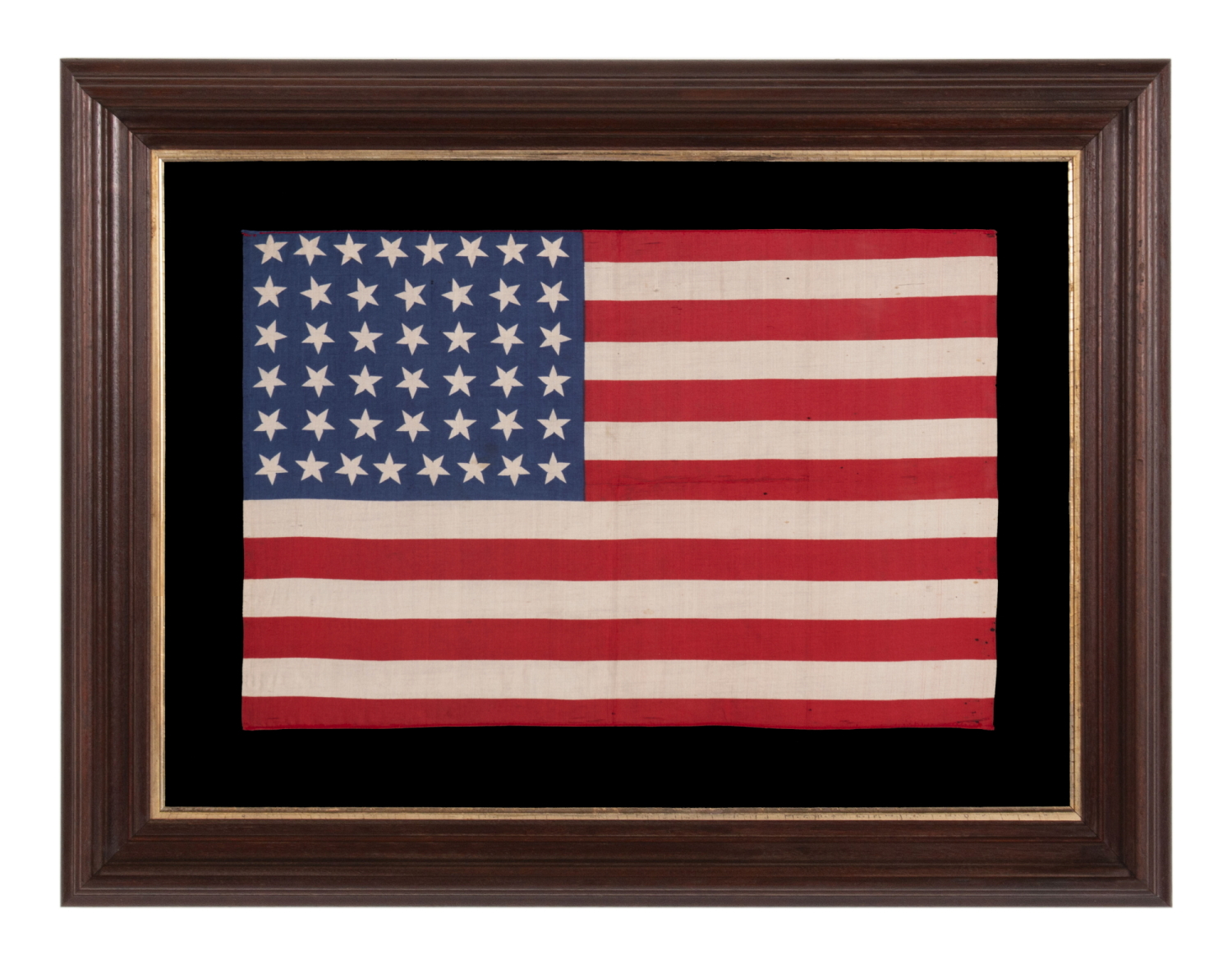


| 44 STARS IN JUSTIFIED ROWS, WITH VARIED STAR POSITIONING, ON A SILK, ANTIQUE AMERICAN FLAG WITH STRIKING COLORS, REFLECTS WYOMING STATEHOOD, circa 1890-1896 |
|
| Web ID: | 44j-919 |
| Available: | In Stock |
| Frame Size (H x L): | 26.25" x 34" |
| Flag Size (H x L): | 15" x 22.5" |
| Description: | |
| 44 star American parade flag, printed on silk, with striking, saturated colors. Wyoming was admitted as the 44th state on July 10th, 1890. Although the 44 star count would not become official until July 4th of the following year, flag makers would have begun to add a 44th star immediately, if not even beforehand, in hopeful anticipation. This became common practice among flag-makers during the latter 19th century, reflecting both their support of westward expansion and a desire not to be one step behind their competitors. While the 44 star count remained official until July 3rd, 1896, it would have generally fallen out of use when Utah gained statehood on January 4th of that year. The stars of the flag are arranged in rectilinear fashion, in justified rows of 8-7-7-7-7-8. Note how they vary in position on their vertical axis. In the first and last rows, these are predictable, oriented with one point directed upward, and the next with one point directed downward (or vice-versa), alternating consistently throughout. This is what I refer to as tumbling stars. In the remainder of the rows, the orientations vary. The overall effect gives the impression of a random scattering, which adds a nice visual element to the flag’s design. The flag’s strong colors also lend a great deal to its appeal. Note how the bright blue canton contrasts beautifully with the scarlet red stripes. The hoist and fly edges of the fabric have selvedge, while the top and bottom are hemmed by machine. Note how the stars are a bit unusual, with tiny notches located in each valley where two arms meet. This feature is shared with other flags, in various star counts, throughout the latter 19th century and the very beginning of the 20th. The presence thereof would almost certainly allow attribution to a particular flag-maker, if any of the examples were signed or marked in some way to identify their origin. Sadly, because they are almost never signed or otherwise identifiable to a place of manufacture, so the maker’s name remains unknown. Mounting: The flag was mounted and framed within our own conservation department, which is led by expert trained staff. We take great care in the mounting and presentation of flags and have framed thousands of examples. The antique, solid walnut molding dates to the period between 1855 and 1875, and retains its original gilded liner. The background is 100% cotton twill, black in color, that was washed and treated for colorfastness. The glazing is U.V. protective acrylic. Condition: There are minor losses in limited areas, mostly at or adjacent to the fly end. There are a series of modest to moderate splits in the 4th red stripe, running for just over ¼ of the flag’s length. These are closed tears and were easily stabilized during the mounting process. There is extremely minor staining, almost not worthy of mention. Many of my clients prefer early flags to show their age and history of use. |
|
| Video: | |
| Collector Level: | Intermediate-Level Collectors and Special Gifts |
| Flag Type: | Parade flag |
| Star Count: | 44 |
| Earliest Date of Origin: | 1890 |
| Latest Date of Origin: | 1896 |
| State/Affiliation: | Wyoming |
| War Association: | 1866-1890 Indian Wars |
| Price: | Please call (717) 676-0545 or (717) 502-1281 |
| E-mail: | info@jeffbridgman.com |
 |
|